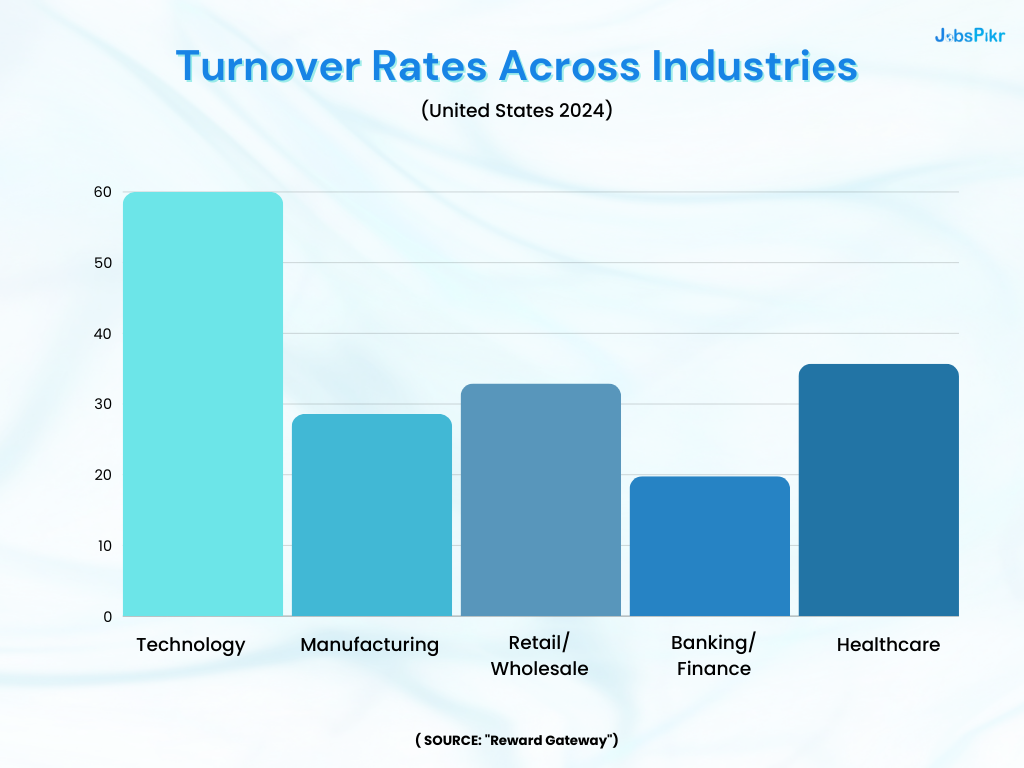Employee turnover and retention rates have a profound impact on any organization’s success. In 2024, companies in the United States continue to grapple with the challenges of maintaining a stable workforce. Drawing on recent data from JobsPikr, this article delves into critical insights around turnover rates, retention strategies, and trends by sector, helping organizations better understand workforce stability and take proactive steps to retain their talent.
Backfilling Vacancies: A Key Priority in 2024
As businesses adapt to changing workforce needs, backfilling positions has remained a priority. In the latter half of 2024, 43% of companies are reportedly planning to backfill roles left vacant due to turnover or internal movements. This rate has seen a slight increase from earlier in the year, reflecting the ongoing importance of turnover management in hiring strategies.
Data Source: RobertHalf.
Average Tenure and Its Impact on Retention

According to the Bureau of Labor Statistics (BLS), the average tenure for employees in the U.S. stands at 3.9 years, down from 4.1 years in 2022. Shorter tenures mean higher recruitment and training costs for organizations, underscoring the importance of retention efforts. Companies with high employee tenure generally see better retention, improved workplace morale, and a stronger company culture.
Source: Bureau of Labor Statistics (BLS).
Industry Turnover Rates and Their Drivers

Turnover rates vary significantly by industry, each facing unique challenges that contribute to their respective turnover rates:
- Technology (~60%): Driven by recent layoffs, tech faces high voluntary and involuntary turnover, as employees seek more stable roles elsewhere.
- Manufacturing (28.6%): A lack of pay transparency, communication gaps, and physical strain lead to high turnover.
- Retail/Wholesale (32.9%): Challenging work environments and limited career growth opportunities contribute to high churn.
- Banking/Finance (19.8%): Younger employees seek more flexibility and better pay, often unavailable in this sector.
- Healthcare:
- Hospitals – 22.7%
- Nursing Homes – 53.3%
- At-Home Care – 31.1%
Healthcare’s demanding nature, compounded by burnout and lack of managerial support, has led to some of the highest turnover rates in the country.
Source: Reward Gateway.
Repeat Postings: A Red Flag for Retention
Repeat job postings, especially within a 6 to 12-month window, often signal retention issues. When the same role is advertised multiple times within a short span, it typically indicates challenges in retaining employees for that position. These issues can be related to workload, managerial support, or lack of career advancement opportunities.
The Role of Internal vs. External Hiring in Retention
A high percentage of internal hires often correlates with better retention, as employees who see clear paths for career progression within their current company are more likely to stay. Notably, in 2023, 77% of all C-suite roles in publicly traded companies were filled internally—a significant increase from 67% five years prior. This shift emphasizes how internal promotion can foster loyalty and reduce turnover at senior levels.
Source: INS Global Consulting
Conclusion
For businesses today, addressing turnover and improving retention require a comprehensive strategy informed by data. Understanding sector-specific trends, enhancing employee engagement, and investing in internal talent can help companies navigate the challenges of today’s talent landscape and build a more resilient workforce. By leveraging these insights, organizations can develop a proactive approach to reduce turnover and foster long-term employee loyalty.
For more such insights, sign up to JobsPikr!


